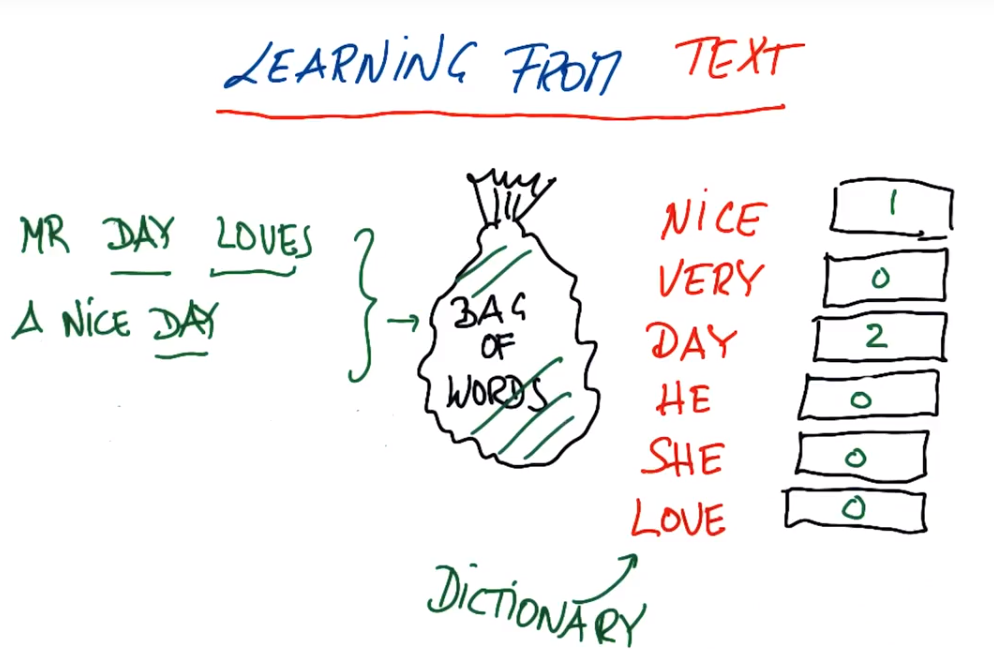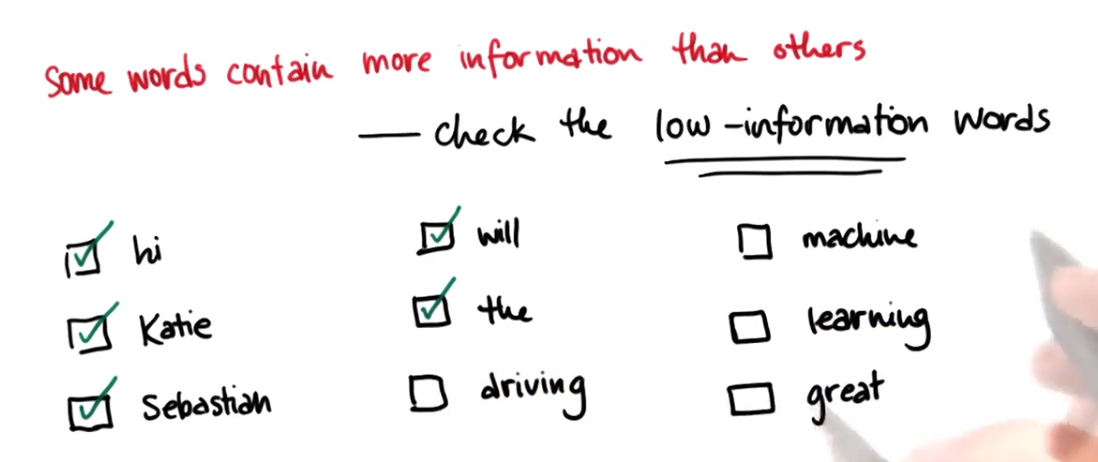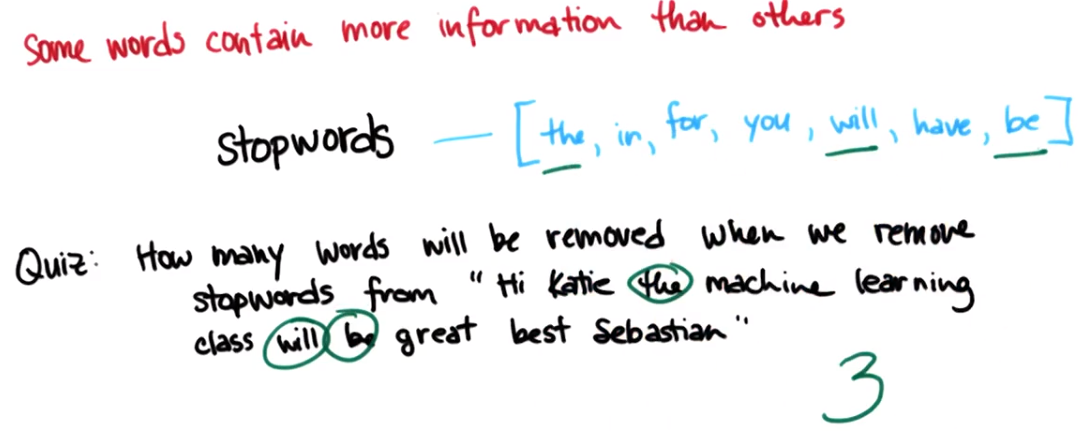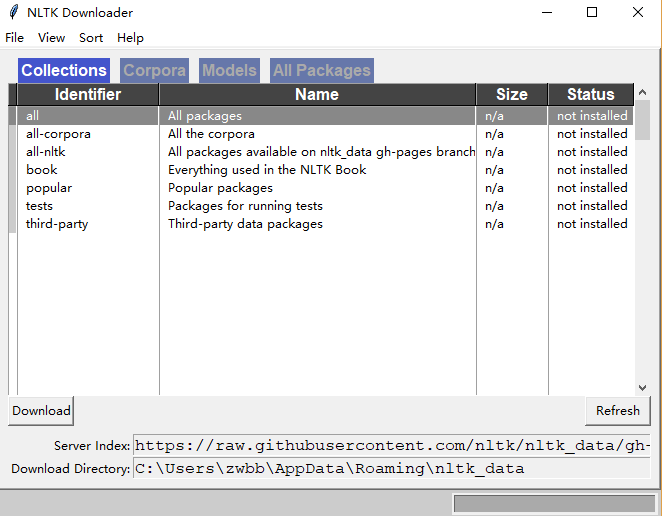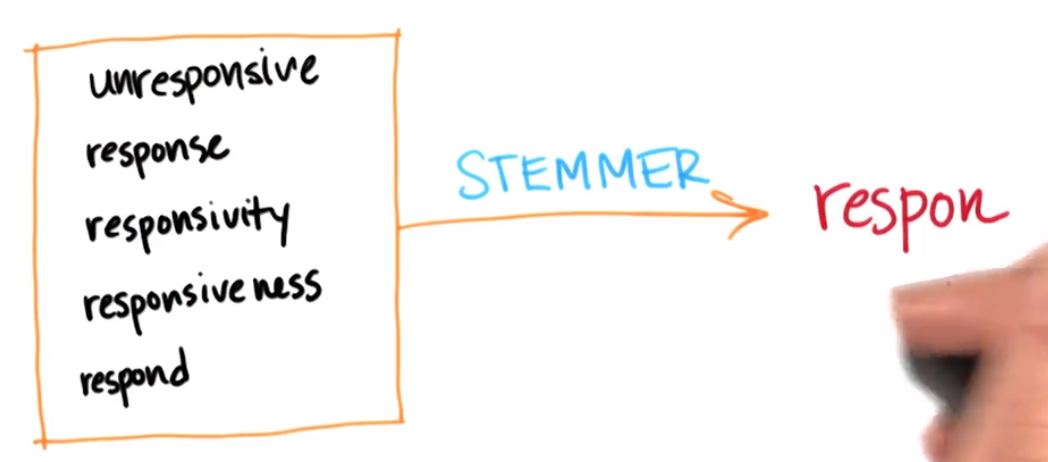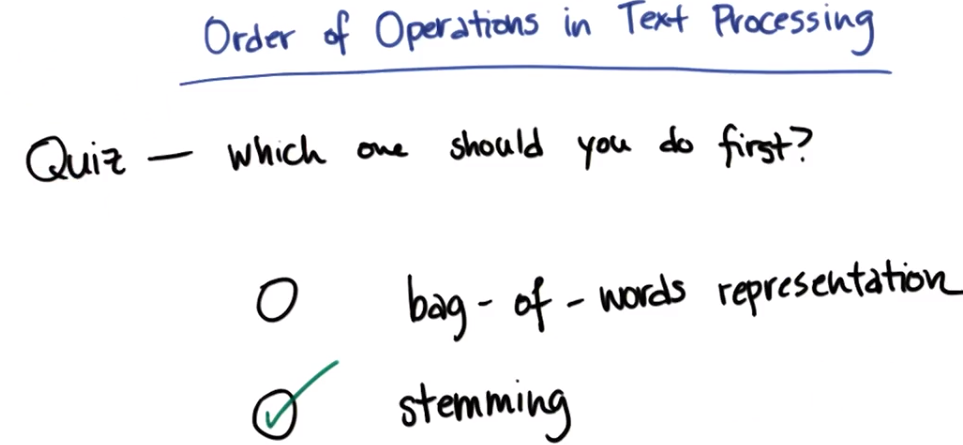Udacity機器學習入門——文字學習
文字學習的基本問題與輸入特徵相關,我們學習的每個檔案、每封郵件或每個書名,它的長度都是不標準的,所以不能講某個單獨的詞作為輸入特徵,因此在文字的機器學習中有個功能——詞袋Bag of Words,基本理念選定一個文字,然後計算文字的頻率
Nice Day與A Very Nice Day
Mr Day Loves a Nice Day
詞袋屬性:短語的單詞順序不會影響頻率(Nice Day 和 Day Nice)、長文字或短語給出的輸入向量完全不同(相同的郵件複製十次然後將十份內容放入同一個文字,得到的結果與一份完全不同)、不能處理多個單片語成的複合短語
在sklearn中詞袋被稱為CountVectorizer
from sklearn.feature_extraction.text import CountVectorizer vectorizer = CountVectorizer() string1 = "hi Katie the self dirving car will be late Best Sebastian" string2 = "Hi Sebastian the machine learning class will be great great great Best Katie" string3 = "Hi Katie the machine learning class will be most excellent" email_list = [string1,string2,string3] bag_of_words = vectorizer.fit(email_list) bag_of_words = vectorizer.transform(email_list)

在進行文字分析時,在詞彙表中,不是所有單詞都是平等的,有些單詞包含的資訊更多,如上圖低資訊單詞;
有些單詞不包含資訊,它們會成為資料集中噪音,因此要移除語料庫,這個單詞清單是停止詞,一般是出現非常頻繁的低資訊單詞,在文字分析中一個常見的預處理步驟就是在處理資料前去除停止詞
NLTK是自然語言工具包,從NLTK中獲取停止詞清單,NLTK需要一個語料庫(即文件)以獲取停止詞,第一次使用時需要下載
<<<153import nltk nltk.donload() from nltk.corpus import stopwords sw = stopwords.words("english") len(sw)
詞幹提取,可以在分類器或迴歸中使用的詞根或詞幹
將下面的五維數輸入空間轉化為一維數,而且不會損失任何真正的資訊
使用NLTK進行詞幹化
from nltk.stem.snowball import SnowballStemmer
stemmer = SnowballStemmer('english')
print stemmer.stem('responsiveness')
print stemmer.stem('responsivity')
print stemmer.stem('unresponsive')
<<<respons
<<<respons
<<<unrespons總體來說,使用詞幹提取器之後能夠很大程度地清理你的語料庫的詞彙表
文字處理中的運算子順序:先詞幹提取(原因:如果先放入詞袋,詞袋內會得到重複多次的相同的詞)
例如:
假設正在討論“responsibility is responsive to responsible people”這一段文字(這句話不合語法)
如果你直接將這段文字放入詞袋,你得到的就是:
[is:1
people: 1
responsibility: 1
responsive: 1
responsible:1]
然後再運用詞幹化,你會得到
[is:1
people:1
respon:1
respon:1
respon:1]
(如果你可以找到方法在 sklearn 中詞幹化計數向量器的物件,這種嘗試最有可能的結果就是你的程式碼會崩潰……)
那樣,你就需要再進行一次後處理來得到以下詞袋,如果你一開始就進行詞幹化,你就會直接獲得這個詞袋了:
[is:1
people:1
respon:3]
顯然,第二個詞袋很可能是你想要的,所以在此處先進行詞幹化可使你獲得正確的答案。
Tf Idf表達——更注重罕見的單詞,幫助分辨資訊
Tf——term frequency 術語頻率——更像詞袋,每個術語或單詞會根據其在一個檔案中出現的次數加重權重(一個詞出現十次其權重比出現一次的詞重十倍)
Idf——inverse document frequency逆向檔案頻率——單詞會根據其在整個語料庫、所有檔案中出現的頻率得到加權
文字學習迷你專案
練習:parseOutText()熱身
- 把程式碼執行一遍就好了
- answer: Hi Everyone If you can read this message youre properly using parseOutText Please proceed to the next part of the project
練習:部署詞幹化
- answer:hi everyon if you can read this messag your proper use parseouttext pleas proceed to the next part of the project
- 這裡要注意filter的使用,要過濾掉空白字元
text_list = filter(None,text_string.split(' '))
stemmer = SnowballStemmer("english")
text_list = [stemmer.stem(item) for item in text_list]
words = ' '.join(text_list)練習:清楚簽名文字
answer:tjonesnsf stephani and sam need nymex calendar
### use parseOutText to extract the text from the opened email
words = parseOutText(email)
### use str.replace() to remove any instances of the words
### ["sara", "shackleton", "chris", "germani"]
stopwords = ["sara", "shackleton", "chris", "germani", "sshacklensf", "cgermannsf"]
for word in stopwords:
words = words.replace(word, "")
words = ' '.join(words.split())
### append the text to word_data
word_data.append(words)
### append a 0 to from_data if email is from Sara, and 1 if email is from Chris
if name == "sara":
from_data.append(0)
elif name == "chris":
from_data.append(1)練習:進行TfIdf
使用 sklearn TfIdf 轉換將 word_data 轉換為 tf-idf 矩陣。刪除英文停止詞。
使用 get_feature_names() 訪問單詞和特徵數字之間的對映,返回一個包含詞彙表所有單詞的列表。有多少不同的單詞?
練習:訪問TfIdf特徵
你 TfId 中的單詞編號 34597 是什麼?
我得到的答案:42282和reqs,且stephaniethank序列為37645
- 正確答案:38757和stephaniethank
for name, from_person in [("sara", from_sara), ("chris", from_chris)]:
for path in from_person:
### only look at first 200 emails when developing
### once everything is working, remove this line to run over full dataset
#temp_counter += 1
#if temp_counter < 200:
path = os.path.join('..', path[:-1])
print path
email = open(path, "r")
### use parseOutText to extract the text from the opened email
words = parseOutText(email)
### use str.replace() to remove any instances of the words
### ["sara", "shackleton", "chris", "germani"]
stopwords = ["sara", "shackleton", "chris", "germani", "sshacklensf", "cgermannsf"]
for word in stopwords:
words = words.replace(word, "")
words = ' '.join(words.split())
### append the text to word_data
word_data.append(words)
### append a 0 to from_data if email is from Sara, and 1 if email is from Chris
if name == "sara":
from_data.append(0)
elif name == "chris":
from_data.append(1)
email.close()
print word_data[152]
print "emails processed"
from_sara.close()
from_chris.close()
pickle.dump( word_data, open("your_word_data.pkl", "w") )
pickle.dump( from_data, open("your_email_authors.pkl", "w") )
### in Part 4, do TfIdf vectorization here
from sklearn.feature_extraction.text import TfidfVectorizer
vectorizer = TfidfVectorizer()
vectorizer.fit_transform(word_data)
feature_names = vectorizer.get_feature_names()
print len(feature_names)
print feature_names[34597]

